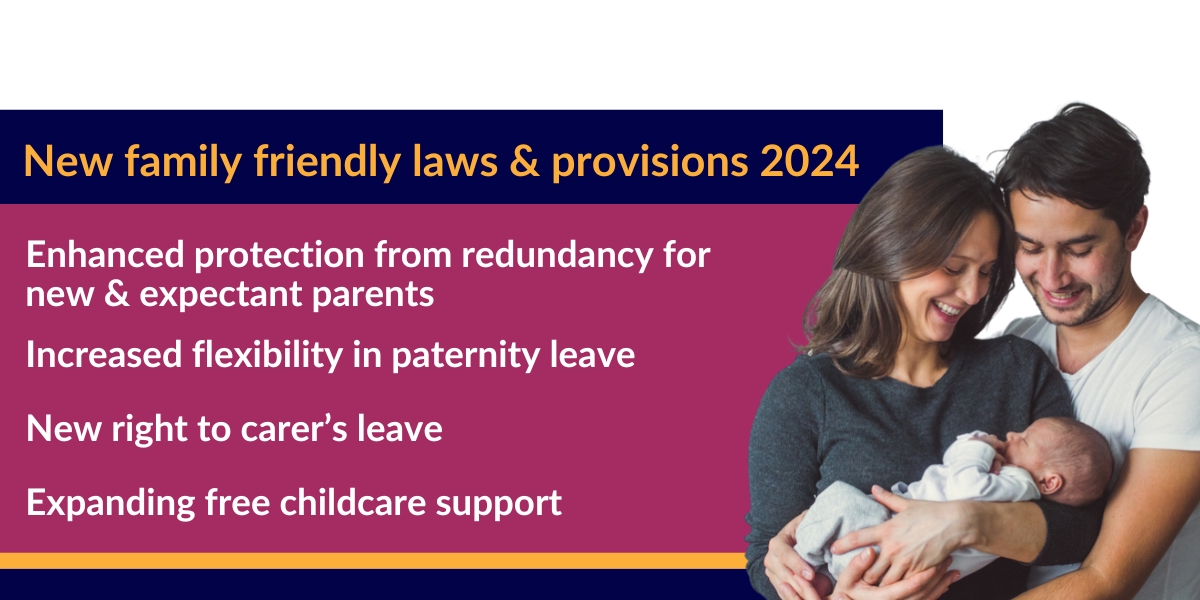Estimated reading time: 13 minutes
Last year the Government introduced a number of family-friendly new laws and provisions aimed at increasing support for working families. This resulted in the following family-friendly laws coming into force from 6th April 2024.
This guide summarises all these new laws, what you need to know, what they offer working parents, and the implications for businesses and employers. Use it to update your staff and to get contracts, policies and practices ready.
New Family-friendly laws from 6th April 2024:
- Enhanced protection from redundancy for pregnant women and new parents
- Increased flexibility in paternity leave
- New right to carers leave which increases the very short term carers leave (i.e emergency unpaid time off for dependents)
- Introducing paid leave for parents of newborns who need specialist neonatal care
- Expanding the ‘free’ childcare support
Enhanced protection from redundancy for pregnant women & new parents
In a redundancy situation, those on maternity leave, shared parental or adoption leave are given priority to be offered any suitable alternative employment, if available.
What’s changing
From 6th April 2024, the new Protection from Redundancy (Pregnancy and Family Leave) Act 2023 extends this protection from redundancy for a further 6 months after maternity and adoption leave ends. The protection will also be extended to
- Any employee who is pregnant, in a ‘protected period of pregnancy’ i.e has informed their employer,
- Any employee who informed her employer she is pregnant and has suffered a miscarriage within the previous 2 weeks,
- anyone who has returned to work from maternity leave, adoption leave and shared parental leave
The new Act doesn’t extend redundancy protection to fathers taking paternity leave. This is on the basis that the new provision is designed to ensure that employers don’t make an early judgment on perfomance in the first few months of someone returning to work after a long absence; not often the case in paternity leave.
The Act is short on detail and will require regulations from the Government setting out precisely how the new protections will work. The Government also has announced it will be publishing guidance ‘to support the commencement of the regulations’ in April 2024. But at the time of writing, we have no sign of either the regulations or the guidance.
The ‘protected period of pregnancy’ is likely to begin once the employee informs her employer that she is pregnant. We wait to see the length of protection afforded those (relatively few) returning from shared parental leave.
Why is it changing
The new legislation is designed to shield expectant and new parents from workplace discrimination. Government research in 2016 (of 3,254 women and 3,034 employers) showed that a substantial number of women, potentially 54,000 if scaled up to the general population, felt that they had to leave their jobs due to pregnancy or maternity related unfair discrimination.
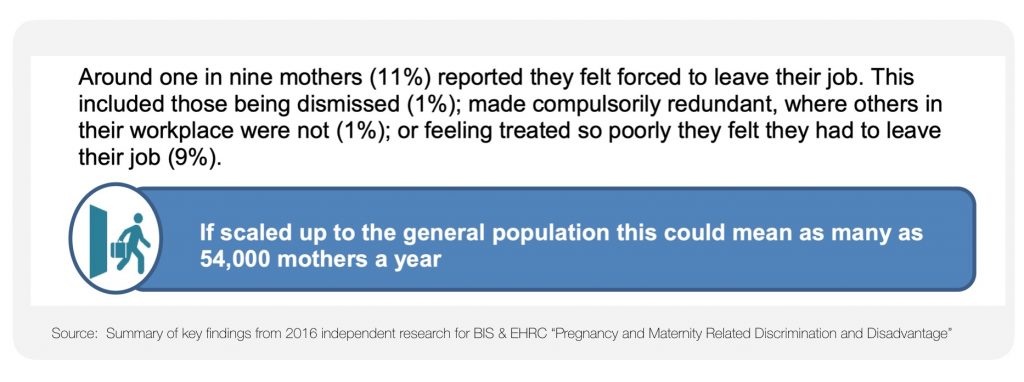
This is a big problem not only for mothers themselves, but for businesses who invest heavily in hiring, training and developing women, only to see them leave their roles as the result of a life event that can be planned for.
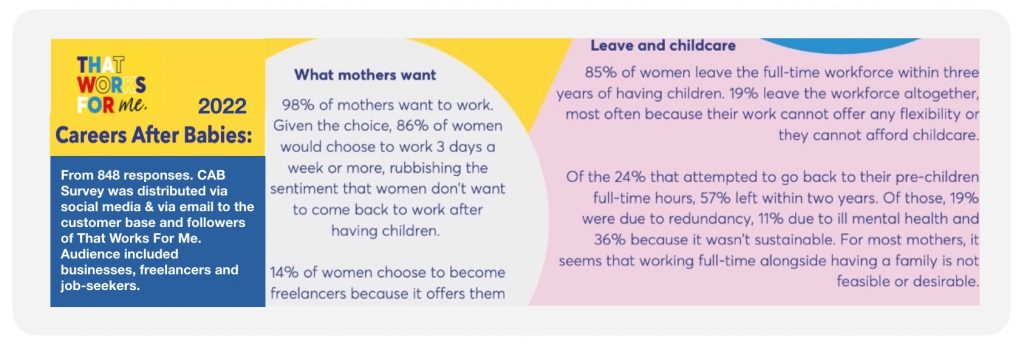
Key implications for employers: things to consider
- when managing a redundancy situation from April 2024 onwards, it’s more vital than ever to remember those of your staff on maternity and other family related leave. Forgetting them could be very expensive, as the potential claim calculation below shows.
- The new law will afford more employees the right to ‘leapfrog’ others into any suitable alternative vacancies, without having to apply for the role.
- It will pose a particular headache when running a redundancy exercise in a workforce that is female-dominated, where many employees must be given priority for suitable alternative vacancies. Employers will have to rethink carefully how they approach redundancy and restructuring programs, which may involve them having to decide who to keep on if multiple members of staff covered by the protection are competing for a single role.
- In terms of policy, and given the above research data, there are clearly sound reasons in favour of protecting pregnant mothers and new parents from discrimination in redundancy situations, avoiding them having to compete for alternative vacancies at a vulnerable time. The existing and expanded laws do give them priority over other employees and are a rare example of positive lawful discrimination.
Even so, there are bound to be situations where the rules seem unfair to team leaders and employees on the ground, such as where it leads to losing a high achieving employee in favour of one with priority status.
Calculating the risk of failing to comply with the new Protection from Redundancy Act 2023
Whilst we wait for the regulations to specify the consequences of failing to offer a protected employee a suitable alternative vacancy, it is likely that failure to do so will mean the employee can claim for automatic unfair dismissal (from day 1).
A female employee who is automatically unfairly dismissed for a pregnancy reason would be entitled to the following compensation depending on her age, length of service, salary, the conduct of the employer and how long it takes her to get another job:
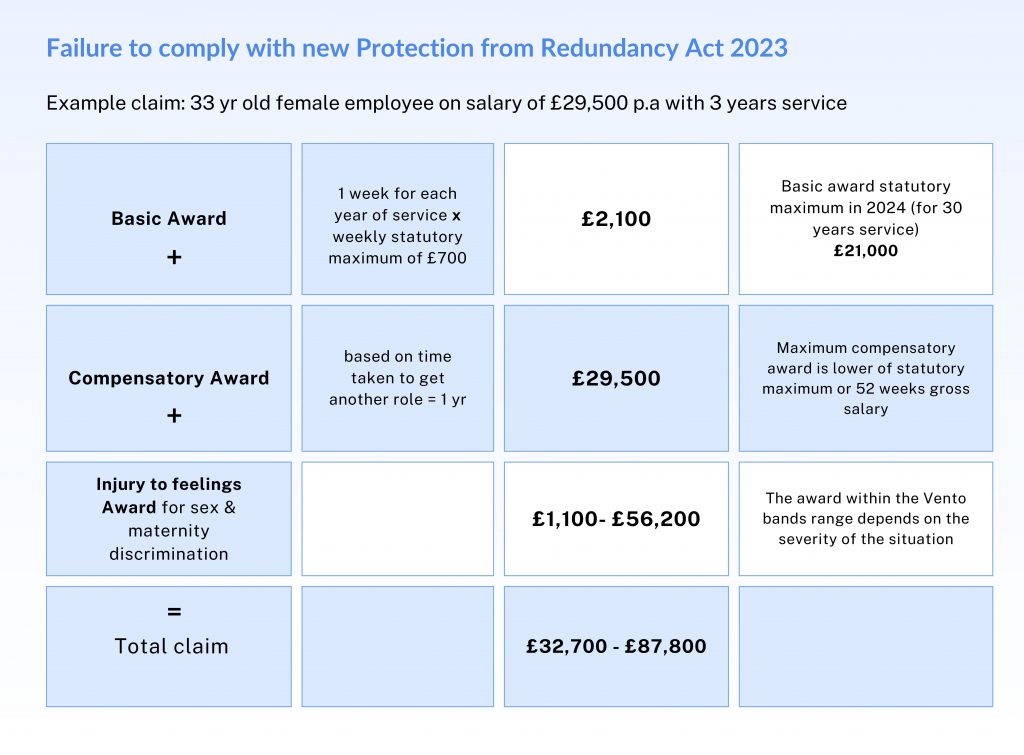
The above amounts are current up to April 2025 when these limits are usually raised in line with inflation.
Remember also, it is highly possible that a parent on maternity leave might wish to be selected for redundancy. Things are now very different, they have a new baby, they have new challenges to deal with, they might want to stay at home to be with their child or to work differently. Good managers know their staff, keep in close touch and can be aware of these issues. These conversations can be a minefield because they touch on protected characteristics under the Equality Act 2010. It’s easy for employers to panic but there is no need. Do call us if we can help you to have that conversation.
Increased flexibility in Paternity Leave
Following the birth or adoption of a child, an eligible father or partner can take one or two weeks’ paternity leave. Under the new Paternity Leave (Amendment) Regulations 2024, the rules have become more flexible. Here is what’s changing:
- The father or partner will be able to divide their two-week paternity leave entitlement into two separate one-week periods, as opposed to the previous requirement of taking it either as a single week or two consecutive weeks.
- They will be able to take the two week paternity leave at any time in the first year after birth (rather than having to take it in the 56 days following birth)
- They will only need to give 28 days’ notice of their intention to take paternity leave (as opposed to the previous requirement that required them to give notice 15 weeks before the expected week of childbirth (EWC).
The Regulations apply in all cases where the EWC is on or after 6 April 2024. Relevant policies will need amending to reflect these changes and managers should be made aware so that absences on paternity leave can be planned and effectively managed.
Its worth noting that practically speaking, this new flexibility doesn’t really go far enough. Allowing new fathers to take paternal leave one day a week in the months following the birth, might be more practical and helpful for new parents.
New right to Carers Leave in 2024
Carer’s Leave allowance, which is unpaid emergency time off for family and dependants, is only to be used for arranging emergency care and for providing emergency cover. It is not to be used to cover situations that are known about beforehand. It is only available for a short period of time, and after a reasonable period of time the caring responsibility should be covered by another person e.g a paid for carer rather than the employee.
What’s changing
The new Carer’s Leave provision (The Carer’s Leave Regulations 2024) comes into force from 6th April 2024. It is a flexible entitlement of one week’s unpaid leave per year for employees who are providing or arranging care for a dependant with a long-term care need. It can be used for providing actual care or to cover for the primary unpaid carer taking respite leave or in order to make arrangements for the provision of care. Key features include:
- It is a day one employment right
- The person being cared for does not need to be a family member or even in the same household. Simply a person who reasonably relies on the employee for care.
- There does need to be a long term care need that lasts for more than 3 months and the need can be physical, or mental, resulting from an illness or an injury)
- Employees are able to self-certify their eligibility for carers’ leave.
- Carers’ leave can be taken flexibly, in either individual days or half days, up to a block of five working days.
- Employees must give notice in writing of their intention to take carer’s leave. They must confirm their entitlement to take it, and give notice that is twice the length of the leave being requested, plus one day, or 3 days notice, whichever is the longer.
- Employers can postpone a request if the operation of the business would be unduly disrupted. In these circumstances, the employer must give notice of the postponement before the leave was due to begin — and explain why it’s necessary. The employer must then allow the leave to be taken within one month of the start date of the leave originally requested. The employer should consult the employee about rescheduling the leave.
- Employees taking carers’ leave are protected and dismissals for reasons connected with exercising the right to carers’ leave would be automatically unfair.
Why is it changing
This is changing in recognition of the myriad of caring responsibilities employees undertake and the many different ways of carrying them out. It is intended to encourage employers to be flexible in dealing with their employees requests, encouraging them to remain in the workforce whilst still providing additional support to dependants who may not even be family members.
Actions for employers
Consider creating a new policy or add a reference to carer’s leave in any existing policy dealing with other family/dependant leave. Get in touch if you need assistance creating or amending your relevant policies.
Neonatal Care Act 2023
Previously there was no provision for parents whose babies needed specialist neonatal care and most partners in this position ended up using their two weeks of parental leave to stay at the hospital followed by being on sick leave if the situation continued.
What is changing
This is a new provision that will allow each parent to take up to 12 weeks of paid leave, to spend time with their premature or sick baby who is receiving neonatal care in a hospital or other agreed care setting.
Neonatal care leave will be a Day one right in addition to maternity and paternity leave.
Why is it changing
In the UK, an estimated 100,000 of the 605,000 babies born each year are admitted to neonatal care. These are the very sick newborn infants who need to have their parents with them whilst they are in specialist neonatal care.
This is a generous provision, and it is not yet clear who is going to pay for it. The law has been given Royal Assent and is now awaiting a commencement date. This is not anticipated before April 2025 and there still need to be changes to HMRC systems, notices for employers and payroll providers, and extensive secondary legislation and guidance.
Expanding free childcare support in 2024 & 2025
From April 2024, Childcare support is to be expanded, rolled out in stages over this year and next and renamed “Tax Free Childcare support”.
What is changing
From April 2024 working parents of 2 yr olds will be able to access 15 hours of free childcare. This will be extended to working parents of all children older than 9 months from September 2024.
Funding will start from the moment maternity or paternity leave ends. There will be different schemes in England, Wales and Scotland.
Who is currently eligible for free childcare?
Under the current system in England, parents of 3-4 year olds who work more (16 hours) a week – and earn less than £100,000 – are entitled to 30 hours a week free childcare with registered childcare providers (nurseries, childminders, playgroups, pre-school, creches etc).
This equates to 570 hours a year, usually taken as 15 hours a week for 38 weeks of the year (during school term time), but parents can chose to take fewer hours over more weeks.
Free childcare hours currently stop when a child starts in reception class.
All parents in a household must work at least 16 hours a week at minimum wage to be eligible for the scheme. This is to prevent parents not in work from claiming the benefit.
What additional free childcare support can parents claim in 2024 & 2025 and when?
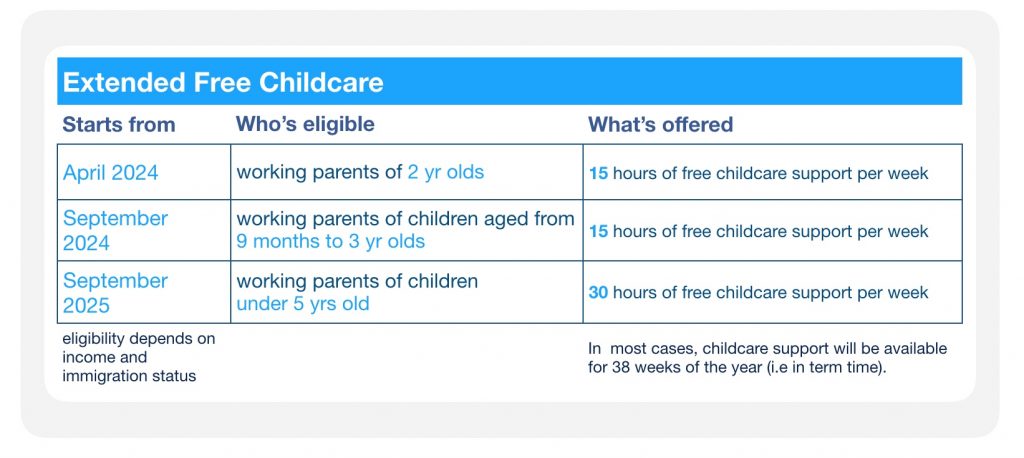
From April 2024, working parents of 2 year olds are able to access 15 hours of free care a week.
From September 2024, working parents of children aged between 9 months and 2 years are able to access 15 hours of free childcare
By September 2025, working parents of children aged 9 months and over will be able to access the promised 30 hours (3 days +) of free childcare prior to their children going to school at 5 yrs old. This will be linked to the birth date and the term that the child starts school
Care must be provided by a registered childcare provider, so it cannot be claimed for informal arrangements with grandparents.
The scheme only applies during the 38 weeks of school term time.
The eligibility requirements remain that all parents in a house hold must work more than 16 hours a week.
Parents can apply on line for a childcare account and get a code for 30 hours to give to their registered provider. Childcare calculator
Why is it changing
The expanded support is designed help working parents and women especially, an estimated 40% of whom say they work less hours than they would like to due to sky high childcare costs.
Key implications for employers
Part-time workers may want to increase their working hours because more childcare is now subsidised rather than these changes leading to the employment of more part time staff overall.
Existing workers doing more hours would save on the costs of hiring and training new staff.
Different parts of the scheme come into force at different times so signpost your employees to check out their own particular circumstances at https://www.gov.uk/childcare-calculator and keep an eye on this helpful gov.uk information page covering the expanding childcare support.
Its worth noting that the success of this depends largely on on supply, i.e actual availability of childcare places, (nurseries, childminders, after school care etc.) which in the case of childminders in particular has nose dived since 2012 and further declined post Covid pandemic. Nurseries are already under significant pressure to offer parents places without knowing how much they will receive from the Government for each place. They are warning they may not be able to honour the Government’s free places pledge. We wait to see in September what happens.
What the new family friendly laws mean for employers
These new family friendly provisions are part of a growing trend in UK employment law. The direction of travel is towards legislation addressing changing working patterns – hydbrid working and its umbrella cateogory flexible working, work life balance and supporting mental health at work. Workplace culture and employee’s perception of it will remain on the agenda and Employers will continue to face these challenges in the months and years ahead.
We are here to help you get contracts, policies and practices ready, to guide you through and keep you ahead of the curve. For advice, please get in touch, our details are below.




